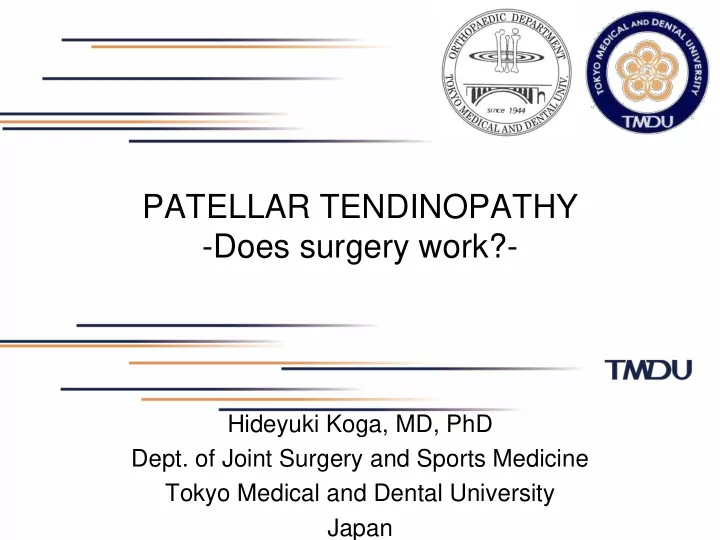

PATELLAR TENDINOPATHY -Does surgery work?- Hideyuki Koga, MD, PhD Dept. of Joint Surgery and Sports Medicine Tokyo Medical and Dental University Japan
Disclosure I have nothing to disclose.
Treatment of patellar tendinopathy • Conservative treatment – Rest (restriction of sports activity) – Physical training • Eccentric training • Heavy slow resistance training – Injection • Sclerosing polidocanol • PRP • Hyaluronan – Extracorporeal shock-wave therapy (ESWT)
Treatment of patellar tendinopathy • Surgical treatment – Open surgery • Removal of abnormal tissues • Longitudinal tenotomy • Excision and/or drilling of inferior patellar pole Ferretti, JBJS-B 2002 – Arthroscopic surgery • Shaving, arthroscopic patellar release (synovectomy, fat pad resection) • Resection of inferior patellar pole • Ultrasound-guided
Overall… First-line monotherapy • Strong evidence – Eccentric training • Limited evidence – Shockwave – Sclerosing injection – PRP – Surgery Larsson, KSSTA 2012 Rodriguez-Merchan, 2013 J Orthopaed Traumatol Everhart, 2017 Arthroscopy
Overall… First-line monotherapy • Strong evidence – Eccentric training Second-line therapy – Surgery: For patients who failed 6 mo. of conservative therapy – Shockwave: Those who failed physical therapy and declined surgery Adjunct treatment – PRP: Could accelerate recovery Corticosteroid therapy is contraindicated!!!
Conservative vs. Surgery (As a first-line therapy) • Sclerosing polidocanol injection vs. Arthroscopic shaving (Willberg, BJSM 2011) – Both good clinical results – Surgery less pain, more satisfied • Eccentric training vs. Open tenotomy – (Bahr, JBJS-B 2006) – 20 training vs. 20 surgery – 5 failed training → Secondary surgery – Rest of training vs. primary surgery NO difference Eccentric training should be tried for 12 weeks before surgery is considered!
Surgery (As a second-line therapy) • Historically… Open surgeries • Surgical procedures comparison (Kaeding, CORR 2006) – Inferior patellar pole • Success rate: 71% resection << 92% no patellar bony work – Paratenon closure • Success rate: closure 85% ≒ no closure 91% – Post-op. immobilization • Success rate: immobilization 82% < no immobilization 95%
Surgery (As a second-line therapy) • Arthroscopic management (case series) (Pascarella, AJSM 2011) – Patients refractory to non-operative management – All arthroscopic surgery • Debridement of IFP • Debridement of abnormal patellar tendon • Excision of the lower patellar pole – 19 of 27 professional athletes returned to same level – All 64 patients returned to sports by 3 months – Failure rate at 3 years: 9.6% Arthroscopic treatment may achieve early return to sports, provide significant improvements
Surgery (As a second-line therapy) • Open vs. Arthroscopic (Brockmeyer, Arthroscopy 2015) – Success rate: 87% open vs. 91% arthroscopic – Faster return to sports with arthroscopic treatment Arthroscopic treatment may lead to significantly faster return to sports and may be the preferred method
Surgery: prognostic factors • Prognostic value on MRI in arthroscopic treatment (Ogon, BMC Muscloskelet Disord2017) a. Bone marrow edema of the inferior patellar pole b. Patellar tendon thickening c. IFP edema d. Infrapatellar bursitis IFP edema (with or w/o BME) was associated with inferior functional outcome and delayed return to sports
Summary First-line monotherapy • Strong evidence – Eccentric training • Limited evidence – Surgery Second-line therapy – Surgery: For patients who failed 6 mo of conservative therapy • Surgery does work for majority of patients who failed conservative therapy • Arthroscopic treatment may lead to significantly faster return to sports and may be the preferred method • There may be prognostic factors that worsen clinical outcomes after surgery
Level 4-5 evidence (My preference)
First-line treatment • Rehabilitation by physiotherapist – Focusing on eccentric training • Adjunct treatment by hyaluronan injection (Muneta, Koga, J Orthop Sci 2012) – Hyaluronan: easy to perform hyaluronan injection under insurance in Japan (easier than PRP) – Injection between PT and IFP at proximal insertion under US guidance – Injection 2 times on average (range 1-11) – 94% success rate
US findings PT Patella IFP Thickening of the patellar tendon Disappearance of fibrillar pattern
PT Patella IFP PT Patella IFP Healthy side
Doppler mode PT Patella IPFP
Before injection Long axis Short axis
During injection Short axis
After injection Long axis Short axis Immediate pain reduction
MRI 4 hours after injection
Surgery as a second-line treatment
US guided arthroscopic surgery (Willberg, BJSM 2011) Operator : Arthroscopic debridement Assistant : Confirm regions by ultrasound Arthroscopic surgery with simultaneous visualization by US Courtesy of Dr. Nakase from Kanazawa Univ.
Case Case : 17 y.o. female Sports : Badminton Failed after 6 months of conservative treatment Lt patellar tendinopathy
Image findings US: long axis MRI ✓ Patellar tendon thickening & low intensity ✓ High intensity at proximal PT ✓ Fibrillar pattern disappearance ✓ IFP edema ✓ Increased blood flow
US guided arthroscopic surgery Arthroscopy US long axis
US guided arthroscopic surgery Weight bearing and ROM ex. permitted 1 day after surgery
Postoperative course ✓ Return to preactivity level at 3 months (pain improved but residual pain persisted) ✓ Pain totally disappeared at 13 months
Take home messages -Does surgery work?- • Limited evidence as a first-line treatment • It does work as a second-line treatment, for patients who failed conservative therapy • Arthroscopic treatment may achieve faster return to sports than open surgery, provide significant improvements • Ultrasound-guided arthroscopic surgery may be the effective surgical procedure • More evidences needed to verify the benefit of surgery • In real world… tailor-made treatment is important!
Recommend
More recommend